By Mark B. Pohlad, Ph.D.
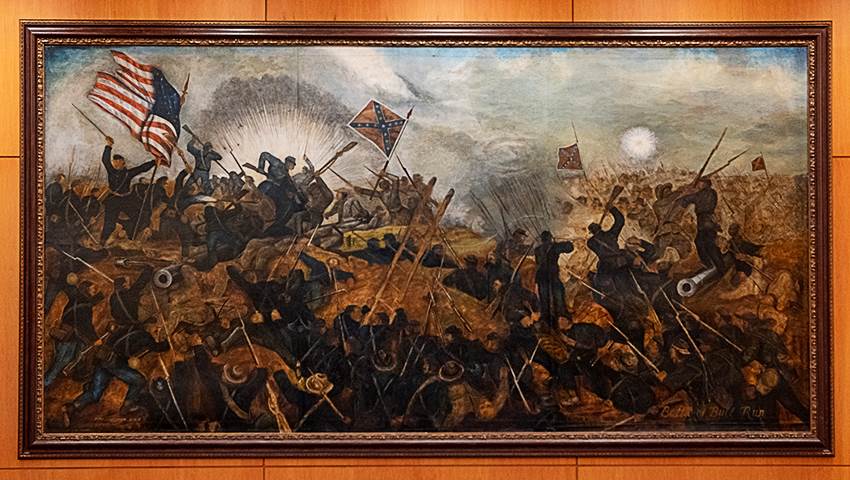
This grand image by James P. Sarver captures the lethal chaos of Civil War battle. We can almost hear the firing of weapons and the soldiers yelling. Across the painting we see a bristling tangle of rifles. A bursting shell in the left center silhouettes a soldier bayoneting another. The hand-to-hand fighting is truly terrible. Rifles are being swung as clubs. A large, vivid Union flag at left contrasts with the confederate banners that recede into the background at right. Every part of the painting shows intriguing detail. For example, a soldier in the bottom right wearing his kepi backwards is a rare and particularly modern touch. In front of him a drummer holds his sticks and carries his drum on his back.
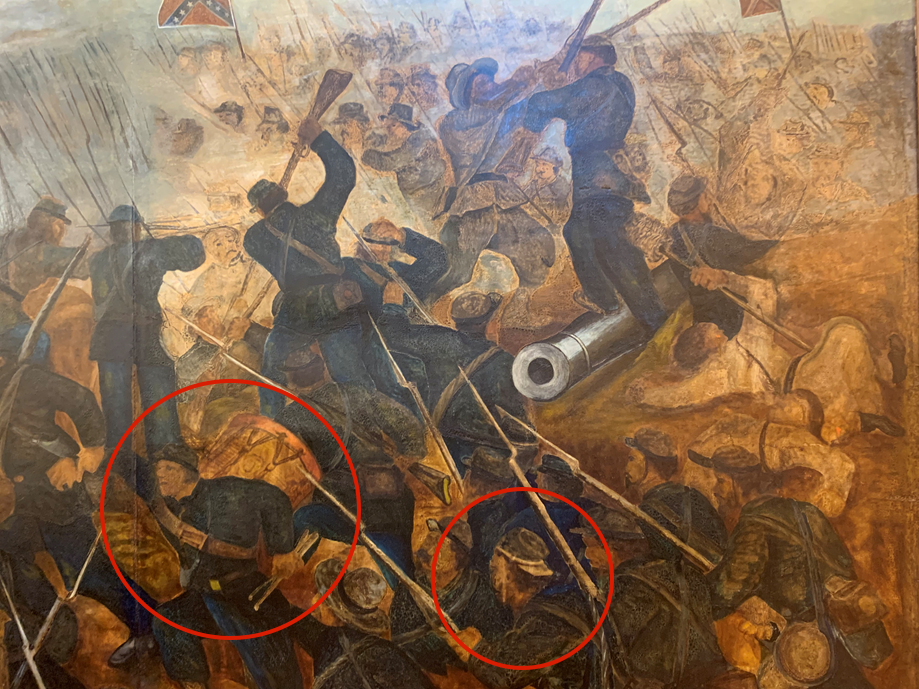 Intriguing details from Sarver’s Battle of Bull Run.
Intriguing details from Sarver’s Battle of Bull Run.
Comparing this painting with one of the most popular images of the Battle of Bull Run shows how vivid and realistic Sarver’s is. A colored lithograph from 1889 by the firm of Kurz & Allison looks amateurish and less believable. By contrast, the violence and mayhem in Sarver’s painting is palpable because he had actually experienced it firsthand. He then lived with those awful memories for another seventy years.
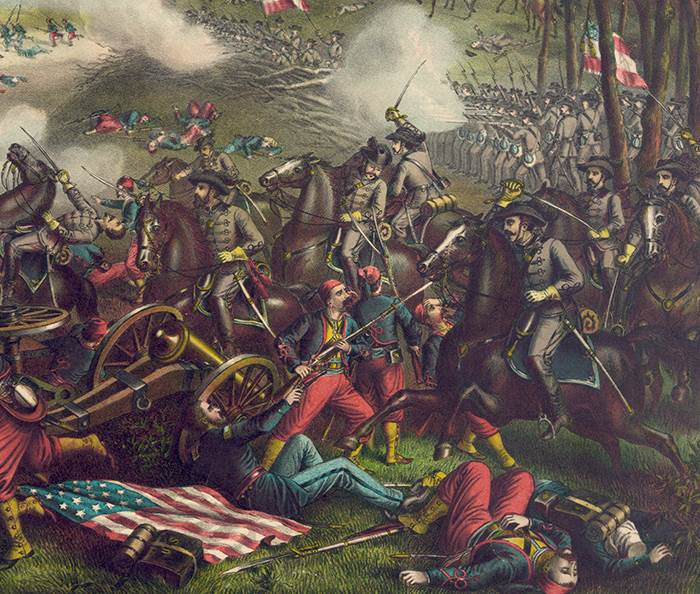 Detail from lithograph of the first Battle of Bull Run by Kurz & Allison, Chicago, 1889 (Library of Congress)
Detail from lithograph of the first Battle of Bull Run by Kurz & Allison, Chicago, 1889 (Library of Congress)
The artist’s biography
James P. Sarver was born in Warren, Pennsylvania, on January 10, 1840, the son of a cabinet maker and commercial painter. The family came to Illinois when young James was ten years old and settled in the greater Joliet area. At age 13, Sarver learned the trade of painter, then printing, then worked as a carriage painter employed in a shop in Aurora. A few years later he was in Chicago, studying scene painting at the famous McVicker’s Theatre (which may have made his paintings, as here, large and particularly dramatic). McVicker’s quickly became the most well-known and enduring downtown playhouse and hosted famous plays and actors like Edwin Booth. Lincoln himself is known to have attended shows there. After a couple years apprenticeship Sarver returned to Joliet, where he enlisted in 1861.
He joined the 20th Illinois Infantry, a unit that saw a great deal of heavy action during the course of the war. At the ferocious Battle of Shiloh (April 6-7, 1862), in Tennessee, Sarver was shot in the forehead and left knee. “These wounds were probably as oddly received as any in the war,” a later newspaper reported. “Surgeons found that the bullet fragments in both his head and knee were parts of the same bullet and fit together perfectly.” It had apparently struck something and split before hitting Sarver. After his recovery, he served as a military railroad man in Tennessee before being mustered out in the fall of 1863.
Back home, Sarver married Lizzie Savage of Poughkeepsie, New York. The couple had four children, all of whom died before 1912. The family lived in Joliet and in various locations in Illinois and Indiana until moving to Springfield in 1869, where James resided until his death sixty-five years later. There he was a sign painter, a portrait artist, and a loyal member of Stephenson Post No. 30 of the Grand Army of the Republic. Sarver sometimes took on specialized painting work including one commission for lettering five medicine chests for the Illinois Surgeon General in 1883. But he was interested in all manner of optical phenomenon. For instance, he made the illustrations for his own lantern slides and was an owner of the “Sarver Stereopticon Company.” When he delivered slide lectures using them, he is said to have “delighted the audience.”
The Battle of Bull Run? Trenches?
The painted title and information on the painting itself attest to Sarver’s skill as a sign painter. The Latin word “pinxit” near his signature means “painted this.” “Pinxit” is seen on Old Master paintings and attests to Sarver’s aspirations to be a bona fide artist. But other painted words introduce some significant historical contradictions and inconsistencies. Sarver’s name is misspelled “Servar,” which is thought have been a consequence of a later conservation (perhaps it was repainted incorrectly).
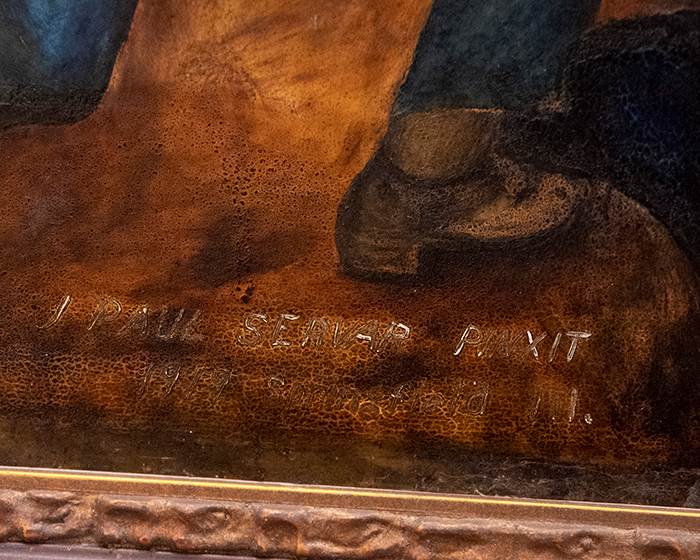 Sarver’s misspelled signature and the word “pinxit.”
Sarver’s misspelled signature and the word “pinxit.”
But the most striking contradiction is within the painting itself. Neither Battle of Bull Run – there were two, a bewildering Union rout in July 1861, and another in August of the following year – featured trenches as seen here. Nor were there trenches at the Battle of Shiloh, where Sarver received his wounds. So what exactly is Sarver painting? World War I had drawn to a close just months before Sarver completed this work. The trench-like features in the painting, as ALPLM historians Jacob Friefeld and Christian McWhirter rightly point out, may be a reference to the recent hellish trench warfare of that global calamity. Sarver may have unconsciously or deliberately added trenches out of a sense of fresh trauma – his own mixed with that of the present war.
But are they trenches at all? Or can they be seen as merely features of the battlefield landscape? The ground on which the soldier’s fight appears to be more blasted and pitted than carved into deliberate defensive trenches. They look more like siege fortifications (intriguingly, Sarver was commissioned by the state of Illinois to paint a vast Battle of Vicksburg on the fiftieth anniversary of that battle). The position of the cannons also suggests that these are not trenches. Their aim would not be, as we see them, into the defenses. (Showing soldiers standing on the cannon barrels is a dramatic touch, by the way). Nor are the “trenches” straight and organized; they seem to meander arbitrarily. Overall, Sarver may have taken liberties with the landscape in order to show a greater number of figures and action. This way of organizing space recalls Chinese landscapes where the space nearest the viewer is at the bottom of the picture, the most distant at the top.
It has been suggested that the painting is the artist’s effort to deal with PTSD (post-traumatic stress disorder), and this may very well be the case. Again, this may have been triggered by the hideous battles of WWI. Notice that there are several soldiers in the painting who are wounded or who are in the process of receiving injuries. Some even grasp their heads, recalling Sarver’s own forehead wound. Overall, the confusion surrounding the identity of the scene (which battle?) and its accuracy (trenches?) suggests that Sarver was not documenting a particular episode from his life, but rather illustrating a nightmare that he had experienced himself.
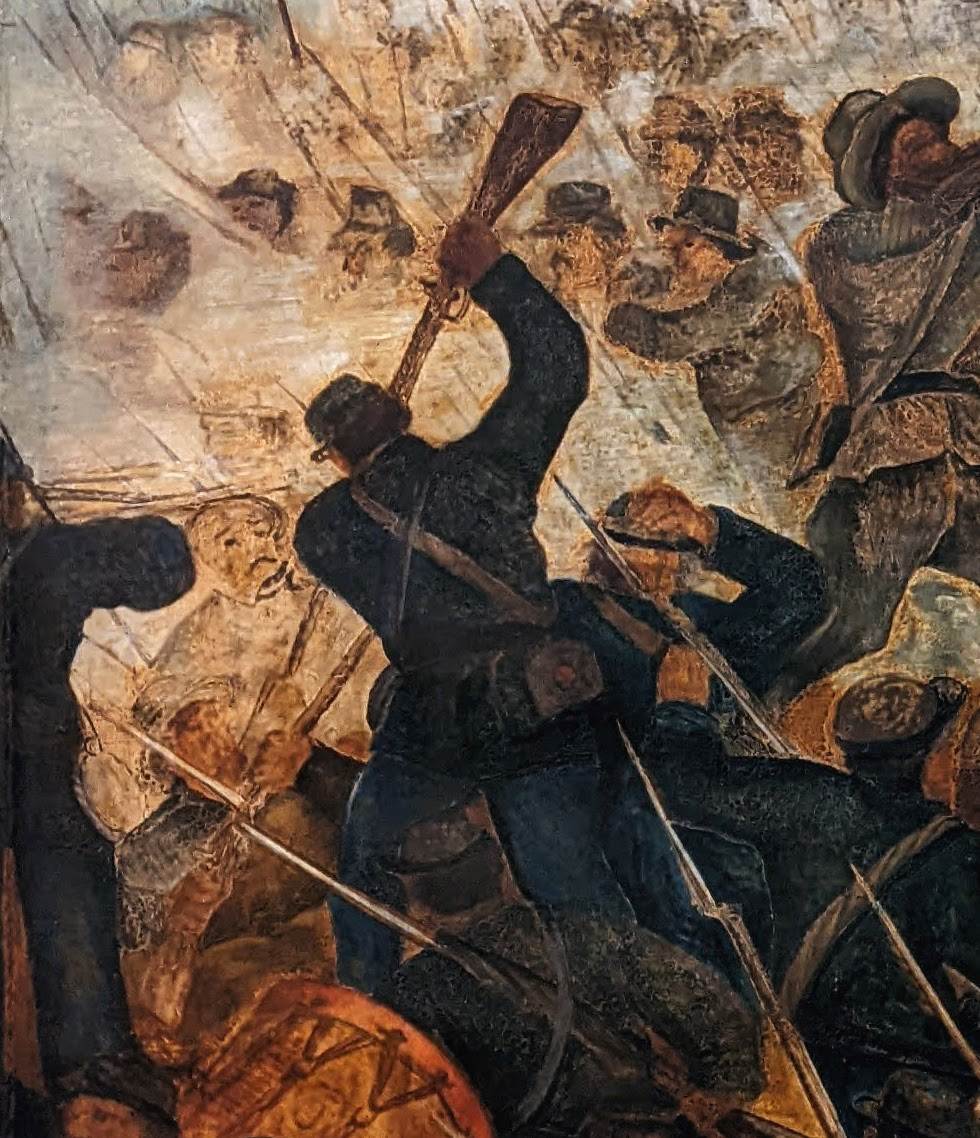 Soldiers bayonetting one another next to someone grasping his head
Soldiers bayonetting one another next to someone grasping his head
But Sarver didn’t just paint images of the Civil War. He was also a veritable font of stories and information about that dramatic era. “Mr. Sarver paints vivid word pictures of the Civil War days,” a 1930s newspaper story ran, “and his many interesting tales and experiences during that time would fill several columns of space.” An upstanding and highly visible resident of Springfield, his personal Thanksgiving Day tradition involved hosting two children from the Washington Street Mission. By the 1930s Sarver was among the very oldest Civil War veterans in Springfield and over the years resided at several locations in town. We can easily imagine him participating in parades, funerals, and G.A.R. events and being a living reminder of the Civil War era. In 1911, Illinois House Resolution 2147 granted him an increase in pension.
While lying in a hospital bed dying of appendicitis in 1935, Sarver was hastily installed as commander of his G.A.R. post, where he was the oldest member. His funeral at his own St. Paul’s Episcopal Church was strictly military and concluded with a WWI veteran playing “Taps.” Sarver had outlived his entire immediate family. Charmingly, the aged widower Sarver left several items to a nurse – provided she was divorced from her husband at the time of his death! – and fifty shares of mining company stock to another young woman. He was buried with a flag that had belonged to his only son, who had died a half-century earlier.
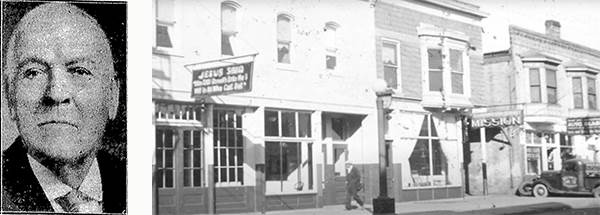 Sarver at about 90. The Washington Street Mission, Springfield, c. 1930
Sarver at about 90. The Washington Street Mission, Springfield, c. 1930
Shortly before his death, Sarver gave this painting to the Cosmopolitan Club (the original name for Springfield College’s International Student Organization) which arranged for the large painting to be hung in the hall of the Associated Building Contractors. A contemporary news article unflatteringly likened the effort to trying to find a home for an “elephant.” By November 1940, that organization no longer existed, and their building’s new tenants did not want the giant painting, either. In 1954 it was acquired by the Women’s Relief Corps, which, poignantly, had performed the flag ceremony at Sarver’s funeral two decades earlier.
Restoration
The restoration of this painting is as intriguing as the painting itself. It was performed by Chicagoan Barry Bauman (1949-2022), one of the most accomplished – and big-hearted – conservators in the country. Bauman trained at the Art Institute of Chicago before launching the Chicago Conservation Center, an innovative clearinghouse for all manner of object restoration (today it’s simply called The Conservation Center). Bauman restored thousands of paintings pro bono knowing that cultural institutions were always strapped for funds. Taking on the Sarver painting in 2006, he charged the ALPLM only for materials, not for his considerable labor.
 Conservator Barry Bauman
Conservator Barry Bauman
But Bauman certainly had his hands full with The Battle of Bull Run. Sarver had painted his battlefield image on several large sheets of paper which he joined together. He then glued the large paper to canvas but did so unevenly. After nearly a century, Bauman removed the darkened and damaged paper from its old support and remounted it on Belgian linen. There was other damage that needed to be repaired, too. In previous years, the painting had occupied several locations in the Old State Capitol. In one, a wayward doorknob had gone completely through it. Once restored, hanging the painting also demanded a complex wiring system across its back. Overall, the care and condition of this dynamic painting reflects the expertise, good judgment, and genuine charity of those invested in Springfield’s art history.
Although Sarver’s Battle of Bull Run is a complicated, even confusing document, it remains an amazing painting. By virtue of its ambitious scale and striking detail it stands out among artworks produced by Civil War veterans. It is a nightmarish image infused with the artist’s personal trauma and memory and vividly illustrates the ferocity of battle even if the exact conflict and geography remains elusive.
Pohlad is an associate professor in the Department of History of Art and Architecture at DePaul University, Chicago
*My special thanks to Christopher Wills, communications director at the Abraham Lincoln Presidential Library and Museum, for his thoughtful partnership and careful editing of this essay.